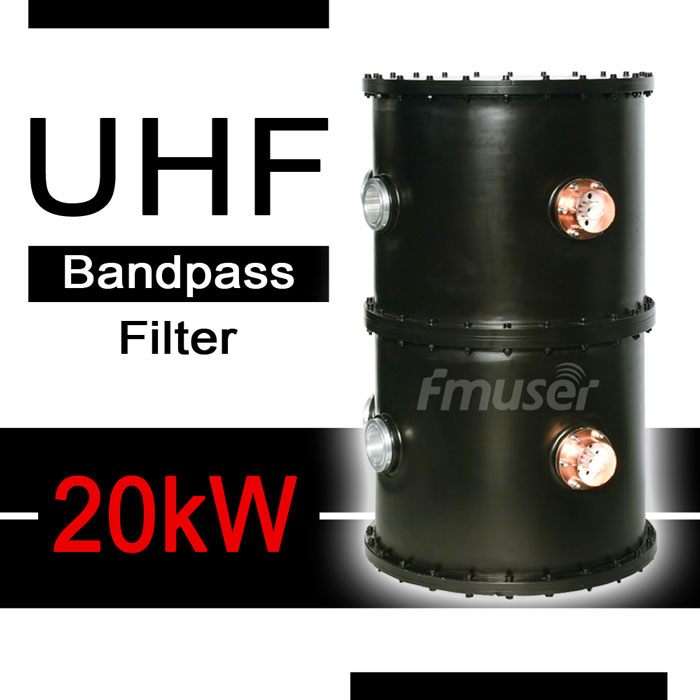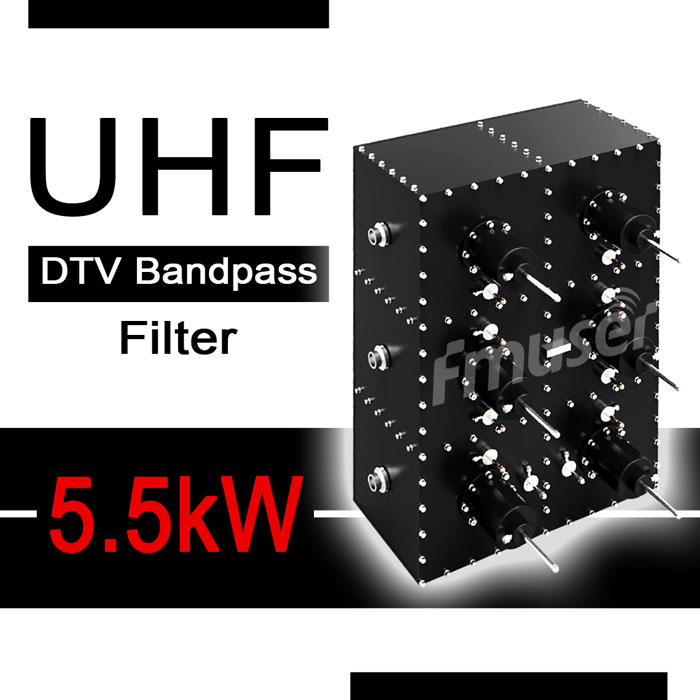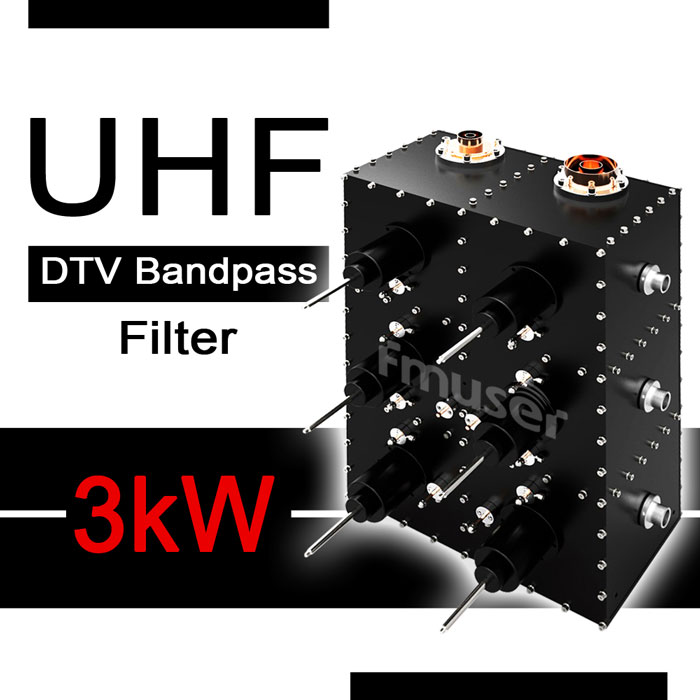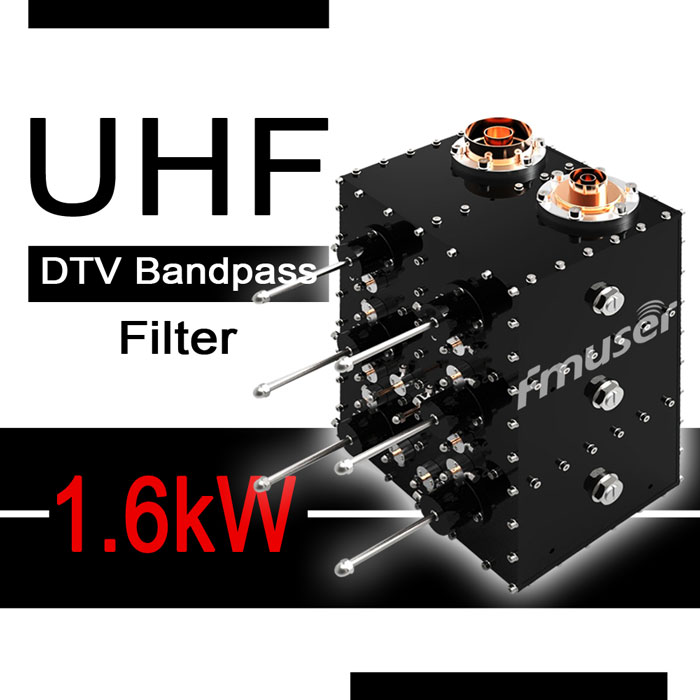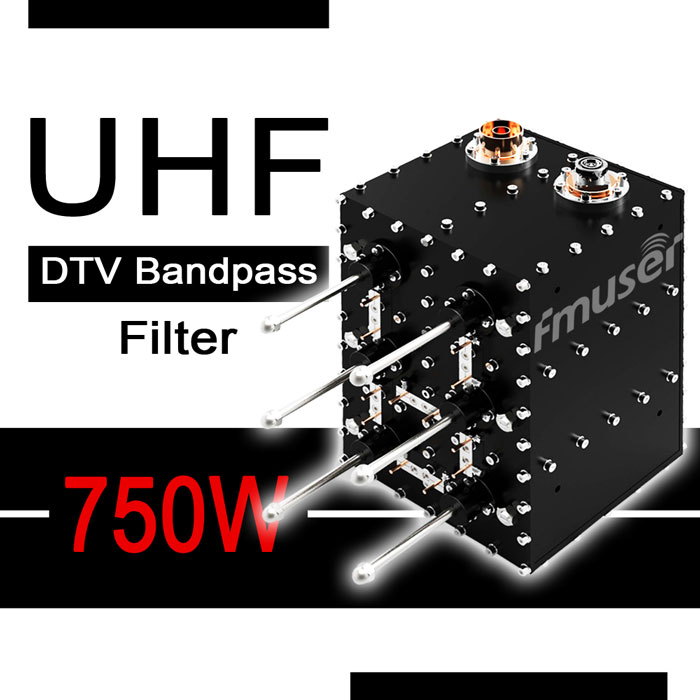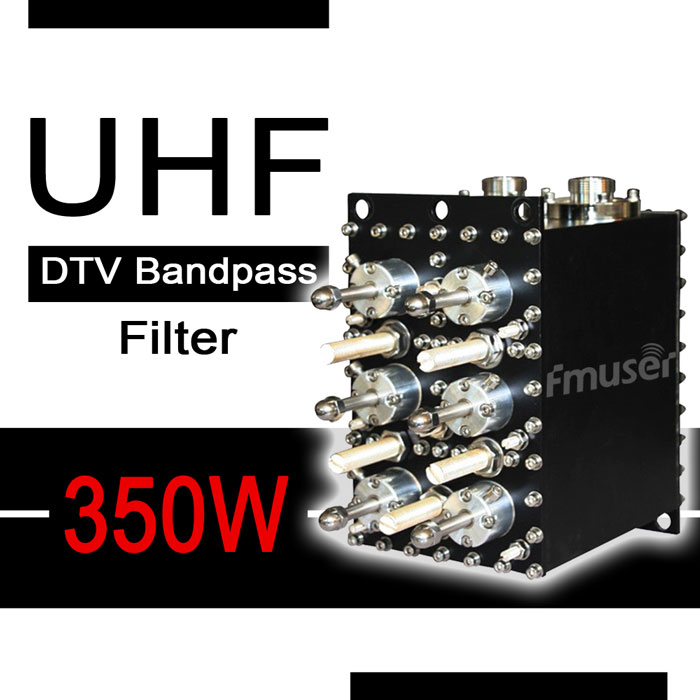
Filtri tal-kavità UHF
A UHF kavità filtru is a tip of radju frekwenza (RF) filtru użati għal separata barra mhux mixtieq sinjali at UHF frekwenzi. It is spiss użati in UHF xandir stazzjonijiet għal filtru barra interferenza sinjali, tali as biswit kanal sinjali, armoniika, u, foloz sinjali, in sabiex għal itejbu l- kwalità of l- riċevuti sinjal. UHF kavità filtri huma importanti għal UHF radju xandir għaliex huma jista jgħinu inaqqsu interferenza u, jiżguraw Li biss l- mixtieqa sinjal is riċevuti. il użu of a UHF kavità filtru in a UHF xandir istazzjon jitlob an inġinier or tekniku għal jinstallaw l- filtru, intunazzjoni it għal l- mixtieqa frekwenza, u, taġġusta it as meħtieġa għal jiżguraw ottimali prestazzjoni.
-
![FMUSER 470-862 MHz 20000W UHF Bandpass Filter 20kW Compact Band Pass Filter With Custom Bandwidth for TX RX System]()
Prezz (USD): Itlob għal kwotazzjoni
Mibjugħa: 31
-
![FMUSER 470-862 MHz 5500W UHF Bandpass Filter 5.5kW Digital TV DTV Band Pass Filter With Coaxial Cavities for TX RX System]()
Prezz (USD): Itlob għal kwotazzjoni
Mibjugħa: 12
-
![FMUSER 470-862 MHz 3000W UHF Bandpass Filter 3kW Digital TV DTV Band Pass Filter With Coaxial Cavities for TX RX System]()
Prezz (USD): Itlob għal kwotazzjoni
Mibjugħa: 16
-
![FMUSER 470-862 MHz 1600W UHF Bandpass Filter 1.6kW Digital TV DTV Band Pass Filter With High Frequency Selectivity for TX RX System]()
Prezz (USD): Itlob għal kwotazzjoni
Mibjugħa: 16
-
![FMUSER 470-862 MHz 750W UHF Bandpass Filter 750W Digital TV DTV Band Pass Filter With Tunable Frequency for TX RX System]()
Prezz (USD): Itlob għal kwotazzjoni
Mibjugħa: 23
-
![FMUSER 470-862 MHz 350W UHF Bandpass Filter 350W Digital TV DTV Band Pass Filter With Custom Bandwidth for TX RX System]()
Prezz (USD): Itlob għal kwotazzjoni
Mibjugħa: 14
- X'inhu filtru tal-kavità UHF?
- Filtru tal-kavità UHF huwa tip ta 'filtru tal-frekwenza tar-radju użat biex jiżola, jgħaddi jew jirrifjuta frekwenzi tar-radju fil-medda ta' frekwenza ultra-għolja (UHF). Tikkonsisti f'kombinazzjoni ta 'ċirkwiti u kavitajiet sintonizzati, li jaġixxu bħala reżonaturi. Is-sinonimu għal filtru tal-kavità UHF huwa filtru bandpass UHF.
- X'inhuma l-aktar applikazzjonijiet komuni tal-filtri tal-kavità UHF?
- L-applikazzjonijiet l-aktar komuni tal-filtri tal-kavità UHF huma fix-xandir bir-radju u televiżiv, komunikazzjoni bis-satellita, navigazzjoni bir-radju, u sistemi tat-telemetrija. Jintużaw biex inaqqsu l-interferenza u jtejbu l-proporzjon tas-sinjal għall-ħoss tas-sistema. Il-filtri tal-kavità UHF huma partikolarment ta 'għajnuna f'applikazzjonijiet fejn medda ta' frekwenza dejqa teħtieġ tkun iżolata, bħal f'sistemi ta 'komunikazzjoni mingħajr fili. Jintużaw ukoll f'netwerks WiFi u ċellulari, ripetituri tar-radju u tat-televiżjoni, sistemi tar-radar, u sistemi ta' komunikazzjoni militari, fost applikazzjonijiet oħra.
- Kif tuża filtru tal-kavità UHF għax-xandir tat-TV?
- 1. Installa l-filtru fis-sistema tal-antenna wara l-istruzzjonijiet tal-manifattur.
2. Kun żgur li l-filtru huwa mwaħħal sew u li s-sistema tal-antenna tkun ertjata b'mod adegwat.
3. Issettja l-firxa tal-frekwenza tal-passband tal-filtru biex tkopri l-firxa tal-frekwenza tax-xandir mixtieqa.
4. Iċċekkja li l-filtru għandu telf ta 'inserzjoni suffiċjenti biex jiżgura li l-qawwa emessa tibqa' fil-limiti.
5. Monitora l-prestazzjoni tal-filtru regolarment biex tiżgura li qed iwettaq kif mistenni.
6. Kun konxju ta 'problemi ta' filtru komuni bħal sinjali barra mill-medda u distorsjoni armonika.
7. Iċċekkja perjodikament il-konnessjonijiet tal-filtru biex tiżgura li jibqgħu siguri.
8. Kun żgur li tuża filtru li huwa xieraq għall-applikazzjoni, peress li mhux il-filtri kollha huma adattati għall-applikazzjonijiet kollha.
- Kif jaħdem il-filtru tal-kavità UHF fix-xandir UHF?
- Filtru tal-kavità UHF jintuża fi stazzjon tax-xandir UHF biex titnaqqas l-interferenza minn sinjali oħra tax-xandir u biex jippermetti li s-sinjal mixtieq jgħaddi. Il-filtru huwa magħmul minn serje ta 'tubi tal-metall irranġati f'mudell partikolari, u kull tubu huwa sintonizzat għal frekwenza differenti. It-tubi huma konnessi flimkien ġewwa għeluq issiġillat u meta s-sinjal mixtieq jintbagħat mill-filtru, jgħaddi mit-tubi li jaqblu mal-frekwenza tiegħu u jiġi mblukkat mit-tubi l-oħra. Dan jiżgura li s-sinjal mixtieq biss jitħalla jgħaddi mill-filtru.
- Għaliex huma meħtieġa filtri tal-kavità UHF għall-istazzjon tax-xandir UHF?
- Filtru tal-kavità UHF huwa komponent importanti ta 'stazzjon tax-xandir UHF minħabba li jipprevjeni lis-sinjal mit-trasmettitur tal-istazzjon milli jinterferixxi ma' sinjali oħra fuq l-istess frekwenza. Tipprevjeni wkoll sinjali minn trasmettituri oħra fuq frekwenzi differenti milli jinterferixxu mas-sinjal mit-trasmettitur tal-istazzjon. Filtru tal-kavità UHF huwa meħtieġ għal stazzjon tax-xandir UHF minħabba li jgħin biex jiżgura li s-sinjal tal-istazzjon ikun qawwi u ċar, mingħajr interferenza minn sinjali oħra.
- X'inhuma t-tipi ta 'filtri tal-kavità UHF u d-differenzi tagħhom bejniethom?
- Hemm tliet tipi ewlenin ta 'filtri tal-kavità UHF: Bandpass, Notch (Bandstop), u Highpass.
Il-filtri tal-passaġġ tal-banda huma ddisinjati biex jgħaddu biss firxa ta' frekwenza speċifika, jew "faxxa", ta' sinjali filwaqt li jimblukkaw il-frekwenzi l-oħra kollha.
Il-filtri Notch (Bandstop) huma ddisinjati biex jimblokkaw firxa ta' frekwenza speċifika, jew "faxxa", ta' sinjali filwaqt li jgħaddu l-frekwenzi l-oħra kollha.
Il-filtri Highpass huma ddisinjati biex jgħaddu frekwenzi għoljin filwaqt li jimblokkaw frekwenzi baxxi.
Qabel ma tagħmel ordni finali, kif tagħżel l-aħjar filtru tal-kavità UHF għal stazzjon tax-xandir UHF?
- Kif tagħżel l-aħjar filtri tal-kavità UHF?
- 1. Identifika l-firxa eżatta tal-frekwenza u l-bandwidth meħtieġa.
2. Iddetermina r-rekwiżiti tal-immaniġġjar tal-enerġija.
3. Ikkunsidra t-tip ta 'filtru meħtieġ (passaġġ baxx, pass għoli, pass band, eċċ.).
4. Ikkunsidra t-telf ta 'inserzjoni, it-telf tar-ritorn, u l-ispeċifikazzjonijiet ta' rifjut.
5. Iddetermina r-rekwiżiti ambjentali (temperatura, umdità, eċċ.).
6. Irriċerka l-marki disponibbli u qabbel l-ispeċifikazzjonijiet tagħhom biex issib l-aħjar għażla.
7. Qabbel il-prezz tal-prodott u sib l-aktar soluzzjoni kost-effettiva.
8. Ikkunsidra kwalunkwe karatteristiċi addizzjonali jew karatteristiċi tad-disinn li jistgħu jkunu meħtieġa.
9. Iċċekkja r-reviżjonijiet tal-prodott u r-rispons minn klijenti oħra.
10. Ikkuntattja lill-manifattur jew lill-fornitur biex tiżgura li l-prodott huwa kompatibbli mas-sistema tiegħek.
- Kif tgħaqqad filtru tal-kavità UHF b'mod korrett?
- 1. Installa l-filtru skond l-istruzzjonijiet provduti mal-filtru.
2. Qabbad l-input tal-filtru (“IN”) mal-output tat-trasmettitur.
3. Qabbad l-output tal-filtru (“OUT”) mal-antenna.
4. Wettaq test tal-knis biex tiżgura li l-filtru huwa konness sew u jaħdem b'mod korrett.
5. Monitora l-prestazzjoni tal-filtru waqt it-tħaddim normali u aġġusta kif meħtieġ.
- X'inhuma t-tagħmir relatat mal-filtru tal-kavità UHF?
- 1. Filtru tal-kavità: Dan huwa l-komponent ewlieni tas-sistema tal-filtru tal-kavità UHF. Huwa akkomodazzjoni tal-metall b'sett ta 'ċirkwiti sintonizzati ddisinjati biex jgħaddu frekwenzi UHF.
2. Amplifikatur RF: Amplifikatur RF jintuża biex isaħħaħ is-saħħa tas-sinjal qabel ma jiġi mitmugħ fil-filtru tal-kavità.
3. Swiċċ RF: Swiċċ RF jintuża biex tagħżel il-kanal UHF mixtieq għat-trażmissjoni.
4. Antenna: Antenna tintuża biex tittrasmetti s-sinjal UHF lejn il-post li jirċievi.
5. Linja ta 'Trażmissjoni: Linja ta' trasmissjoni tintuża biex tgħaqqad il-filtru tal-kavità UHF mal-antenna.
6. Provvista ta 'Enerġija: Provvista ta' enerġija tintuża biex tipprovdi l-enerġija meħtieġa lill-filtru tal-kavità UHF.
- X'inhuma l-aktar speċifikazzjonijiet importanti ta 'filtru tal-kavità UHF?
- Speċifikazzjonijiet Fiżiċi
- Daqs: Il-filtri tal-kavità UHF jidħlu f'varjetà ta 'daqsijiet, skont il-firxa u t-tip tal-frekwenza. Id-daqs tal-filtru jiddependi min-numru ta 'kavitajiet użati fil-filtru.
- Telf ta 'Inserzjoni: Dan huwa t-telf tas-saħħa tas-sinjal hekk kif is-sinjal jgħaddi mill-filtru. Huwa tipikament imkejjel f'decibels (dB).
- Telf ta 'Ritorn: Dan huwa l-ammont ta' enerġija riflessa lura fil-filtru meta jintbagħat sinjal. Huwa mkejjel f'decibels (dB).
- Bandwidth: Din hija l-firxa ta 'frekwenzi li l-filtru jista' jgħaddi minnha. Il-bandwidth huwa tipikament imkejjel f'hertz (Hz).
Speċifikazzjonijiet RF
- Frekwenza taċ-Ċentru: Din hija l-frekwenza li fiha l-filtru jgħaddi l-aktar ammont ta 'enerġija. Huwa tipikament imkejjel f'hertz (Hz).
- Attenwazzjoni: Dan huwa l-ammont ta 'enerġija li l-filtru se jimblokka fi frekwenzi differenti. Huwa tipikament imkejjel f'decibels (dB).
- Ċaħda: Dan huwa l-ammont ta 'enerġija li l-filtru se jimblokka barra mill-firxa ta' frekwenza mixtieqa. Huwa tipikament imkejjel f'decibels (dB).
- Dewmien tal-Grupp: Dan huwa l-ammont ta 'ħin li jieħu biex sinjal jgħaddi mill-filtru fi frekwenzi differenti. Huwa mkejjel f'sekondi (s).
- Kif iżżomm filtru tal-kavità UHF bħala inġinier tal-boadcast?
- 1. Iċċekkja l-livelli tal-qawwa tas-sistema.
2. Spezzjona l-filtru tal-kavità UHF għal trab, ħmieġ, korrużjoni, u debris ieħor.
3. Kun żgur li l-filtru jkun imqiegħed sew u mqabbad mas-sistema tal-antenna.
4. Ittestja l-prestazzjoni tal-filtru b'analizzatur tal-ispettru.
5. Naddaf il-filtru b'pinzell artab u arja kkompressata.
6. Kejjel it-telf ta 'inserzjoni u t-telf tar-ritorn tal-filtru.
7. Spezzjona l-viti tal-irfinar tal-filtru biex tiżgura li huma ssettjati b'mod korrett.
8. Iċċekkja t-temperatura u l-umdità tal-filtru.
9. Ittestja l-filtru b'ġeneratur tas-sinjali biex tiżgura li qed jaħdem sew.
10. Kun żgur li ċ-ċifra tal-istorbju tal-filtru tkun f'livelli aċċettabbli.
- Kif isewwi sew filtru tal-kavità UHF?
- It-tiswija ta 'filtru tal-kavità UHF tista' ssir fi ftit passi. L-ewwel, huwa importanti li tiġi djanjostikata l-problema. Għandha ssir spezzjoni viżwali tal-filtru u l-komponenti tiegħu biex tiċċekkja għal xi partijiet miksura, konnessjonijiet laxki, jew kwalunkwe sinjali oħra ta 'ħsara jew ħsara.
Jekk jinstabu partijiet miksura, huwa importanti li tiddetermina l-kawża tal-ħsara qabel ma tissostitwixxi l-komponenti bil-ħsara. Jekk jiġi determinat li l-problema hija dovuta għal difett tal-manifattura jew ħsara mekkanika, allura l-partijiet għandhom jiġu sostitwiti b'oħrajn ġodda.
Ladarba l-partijiet difettużi jkunu ġew sostitwiti, il-filtru għandu jerġa 'jiġi mmuntat skond l-istruzzjonijiet tal-manifattur. Dan jista 'jinkludi l-konnessjoni mill-ġdid tal-komponenti varji u l-aġġustament ta' kwalunkwe settings fuq il-filtru.
Fl-aħħarnett, il-filtru għandu jiġi ttestjat biex jiġi żgurat li qed jaħdem b'mod korrett. Jekk jinstabu xi kwistjonijiet, il-proċess għandu jiġi ripetut sakemm il-filtru jaħdem sew.
- Kif tippakkja b'mod korrett filtru tal-kavità UHF qabel u wara l-kunsinna?
- 1. Agħżel materjal tal-ippakkjar li huwa anti-statiku, reżistenti għall-ilma u kontra x-xokk.
2. Agħżel pakkett li jkun ikkuttunat tajjeb u li jipprovdi protezzjoni adegwata waqt it-trasport.
3. Kun żgur li l-ippakkjar huwa ssiġillat kif suppost biex jipprevjeni d-dħul ta 'kwalunkwe umdità jew kontaminanti.
4. Kun żgur li l-pakkett huwa ttikkettjat kif suppost u jindika b'mod ċar il-kontenut.
5. Kun żgur li l-pakkett huwa daqs tajjeb għall-oġġett li qed jintbagħat.
6. Kun żgur li l-pakkett ikun imwaħħal jew imwaħħal sew biex jipprevjeni kwalunkwe ċaqliq waqt it-transitu.
7. Kun żgur li tinkludi kwalunkwe dokumentazzjoni jew ċertifikati meħtieġa meħtieġa għall-oġġett li qed jintbagħat.
8. Kun żgur li tikkunsidra kwalunkwe rekwiżit addizzjonali għat-tbaħħir jew l-immaniġġjar tal-oġġett, bħal restrizzjonijiet ta 'temperatura jew vibrazzjoni.
- X'inhu l-casing tal-filtru tal-kavità UHF magħmul minn?
- Il-kisi ta 'filtru tal-kavità UHF huwa tipikament magħmul minn materjal dielettriku, bħal ċeramika, ħġieġ jew plastik. Dan il-materjal dielettriku huwa importanti għall-prestazzjoni tal-filtru, peress li jiddetermina l-ammont ta 'enerġija li tgħaddi mill-filtru. Jekk jintuża materjal ħażin, il-filtru jista 'ma jkunx jista' jiffiltra l-frekwenzi mixtieqa, li jirriżulta f'prestazzjoni fqira. Barra minn hekk, it-tip ta 'materjal jista' jaffettwa t-telf ta 'inserzjoni tal-filtru, telf ta' ritorn, u parametri oħra ta 'prestazzjoni.
- X'inhi l-istruttura bażika ta 'filtru tal-kavità UHF?
- L-istruttura bażika ta 'filtru tal-kavità UHF tikkonsisti f'erba' partijiet ewlenin: il-post tal-igganċjar, ir-reżonaturi, l-iris, u l-output.
Il-post tal-igganċjar jipprovdi l-konnessjoni elettrika bejn id-dħul u l-ħruġ tal-filtru. Jintuża wkoll biex jaġġusta l-ammont ta 'enerġija li huwa akkoppjat bejn id-dħul u l-ħruġ tal-filtru.
Ir-reżonaturi huma l-komponenti ewlenin tal-filtru. Jintużaw biex jinkisbu l-karatteristiċi mixtieqa tar-rispons tal-frekwenza.
L-iris hija pjanċa tal-metall aġġustabbli li tintuża biex tixgħel il-frekwenzi tal-filtru. Huwa tipikament użat biex jinkiseb rispons aktar dejjaq fuq medda ta 'frekwenza speċifika.
L-output jintuża biex jipprovdi konnessjoni elettrika mal-output tal-filtru.
Il-prestazzjoni u l-attributi tal-filtru huma ddeterminati mill-kombinazzjoni tal-komponenti, id-disinn tagħhom, u l-irfinar tal-iris. Mingħajr l-ebda waħda minn dawn l-istrutturi, il-filtru ma jistax jaħdem b'mod normali.
- Kif tħaddem sew filtru tal-kavità UHF?
- Il-persuna assenjata biex timmaniġġja filtru tal-kavità UHF għandu jkollha fehim tajjeb tal-elettronika u tkun familjari mal-kejl tal-frekwenza tar-radju (RF), partikolarment fir-rigward tat-tħaddim tal-filtru. Għandhom ikunu jafu wkoll fl-użu tat-tagħmir tat-test u tal-kejl, kif ukoll fil-prinċipji tad-disinn tal-antenna u l-irfinar tal-filtri. Għandhom ukoll ikollhom esperjenza b'sistemi ta' xandir UHF u jkunu kapaċi jsolvu xi problemi li jistgħu jinqalgħu.
- Kif inti?
- jien tajjeb
IKKUNTATJANA


GRUPP INTERNAZZJONALI FMUSER LIMITED.
Aħna dejjem nipprovdu lill-klijenti tagħna prodotti affidabbli u servizzi meqjusa.
Jekk tixtieq iżżomm kuntatt magħna direttament, jekk jogħġbok mur fuq Ikkuntatjana
